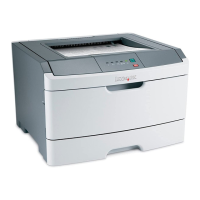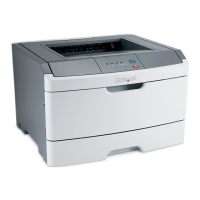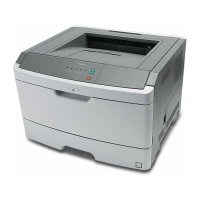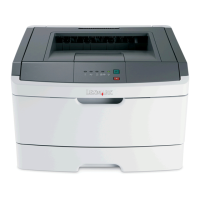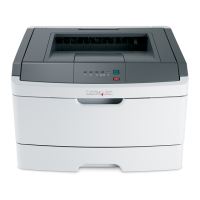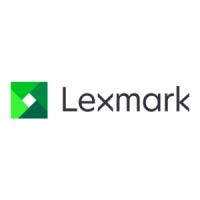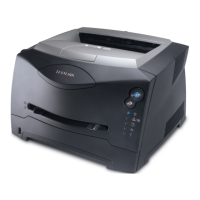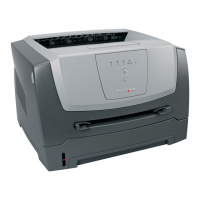Do you have a question about the Lexmark E260d Series and is the answer not in the manual?
Covers potential hazards like injury, hot surfaces, and electric shock from printer use.
Guidance on choosing a suitable location for the printer, considering space and environment.
Details the function of each light and button on the printer control panel.
Instructions for customizing printer connectivity and memory capacity by adding optional cards.
Explains how to interpret the various light sequences on the printer control panel.
Details the meaning and actions for primary light sequences on the control panel.
Explains secondary error codes and how to interpret their light sequences.
Step-by-step guide for replacing the toner cartridge when it is low or empty.
Procedure for replacing the photoconductor kit when it reaches its end of life.
Tips to avoid jams and information on accessing jam areas.
Explains jam lights, messages, and how to access specific jam locations.
Procedure to remove paper jams located behind the photoconductor kit and toner cartridge.
Steps to remove paper jams from the standard exit bin.
Procedure to remove paper jams located in or behind the standard 250-sheet tray (Tray 1).
Procedure to remove paper jams located in or behind the optional 250- or 550-sheet tray (Tray 2).
Steps for removing paper jams from the printer's manual feeder.
Procedure to remove paper jams accessible from the printer's rear door.
Guides for interpreting and resolving common printer messages.
Resolving issues related to defective, unsupported, or excess flash options.
Resolving problems with too many trays, incompatible trays, or toner replacement.
Checklist for common issues like power, cable connections, and option installation.
Addressing issues like jobs not printing, slow jobs, paper jams, and incorrect character output.
Diagnosing and resolving various print quality issues like streaks, poor color, and light/dark prints.
Guidance on how to contact customer support, including necessary information.
Covers potential hazards like injury, hot surfaces, and electric shock from printer use.
Guidance on choosing a suitable location for the printer, considering space and environment.
Details the function of each light and button on the printer control panel.
Instructions for customizing printer connectivity and memory capacity by adding optional cards.
Explains how to interpret the various light sequences on the printer control panel.
Details the meaning and actions for primary light sequences on the control panel.
Explains secondary error codes and how to interpret their light sequences.
Step-by-step guide for replacing the toner cartridge when it is low or empty.
Procedure for replacing the photoconductor kit when it reaches its end of life.
Tips to avoid jams and information on accessing jam areas.
Explains jam lights, messages, and how to access specific jam locations.
Procedure to remove paper jams located behind the photoconductor kit and toner cartridge.
Steps to remove paper jams from the standard exit bin.
Procedure to remove paper jams located in or behind the standard 250-sheet tray (Tray 1).
Procedure to remove paper jams located in or behind the optional 250- or 550-sheet tray (Tray 2).
Steps for removing paper jams from the printer's manual feeder.
Procedure to remove paper jams accessible from the printer's rear door.
Guides for interpreting and resolving common printer messages.
Resolving issues related to defective, unsupported, or excess flash options.
Resolving problems with too many trays, incompatible trays, or toner replacement.
Checklist for common issues like power, cable connections, and option installation.
Addressing issues like jobs not printing, slow jobs, paper jams, and incorrect character output.
Diagnosing and resolving various print quality issues like streaks, poor color, and light/dark prints.
Guidance on how to contact customer support, including necessary information.
| Print Technology | Monochrome Laser |
|---|---|
| Print Speed | Up to 35 ppm |
| Print Resolution | 1200 x 1200 dpi |
| Processor Speed | 400 MHz |
| Connectivity | USB 2.0, Parallel |
| Monthly Duty Cycle | Up to 50, 000 pages |
| Paper Output Capacity | 150 sheets |
| Operating System Compatibility | Windows, Mac OS, Linux |
| Input Capacity | 250-Sheet Input Tray |
| Media Types Supported | Card Stock, Envelopes, Labels, Plain Paper, Transparencies |
| Media Sizes Supported | A4, A5, Executive, Folio, Letter, Legal, Statement, Universal |
| Maximum Paper Size | 8.5 x 14 inches |
| Duplex Printing | Standard |
| Recommended Monthly Page Volume | 500 - 2, 500 pages |
